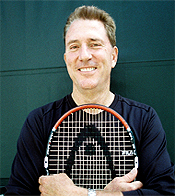
Overview: Heavy Ball
Most players think they know a "heavy" ball when they play against it. But I've never heard a coherent explanation of exactly what it is. What makes a player's forehand or serve "heavy as a brick"? OR is there even such a thing at all? Frankly some of the explanations of the I've heard make the least sense of anything I've encountered in coaching and teaching. So this section begins a quest to try to unravel the "mysteries of the heavy ball." We know that--if there is such a thingthe heavy ball must involve some combination of ball speed and ball spin. But understanding how they combine presupposes knowing something about speed and spin in the first place. Until very recently, we knew almost nothing about either. The radar gun gave us the initial velocity on the serve, but nothing about what happened to the initial speed over the flight of the ball, or anything about the speed of any of the other strokes. As for spin, we knew literally zero. This is because it had never been measured in the pro game. In 1997 that started to change when I began to work with a brilliant scientist name Nasif Iskander, who happened to teach physics at the same high school in San Francisco where I coached tennis . Nasif and I launched a filming project designed to study ball speed in pro tennis. This led to a further collaboration with other researchers that expanded the research to include the study of spin, using high speed digital cameras. Some of this filming was done at the U.S. Open, partially funded by a grant from the educational arm of NASA . These initial studies of speed and spin were done separately. Later, working through the non-profit foundation we created (www.AdvancedTennis.com) we filmed speed and spin simultaneously, and began to analyze the complex interactions they could have over the course of the flight of a professional shot, for example, a 120mph Pete Sampras serve. This section will outline what we discovered at each stage in our quest, how we did it, and also, the implications for coaching and teaching. The results, I think, may surprise youand definitely take the first steps toward trying to unravel the heavy ball mystery. Really, however, we are just at the beginning of this work. In the last year, Advanced Tennis has agreed to collaborate with Paul Hawkins, the director of Hawkeye technologies and the man who brought the "Shot Spot" technology to tennis. We are in the process of combining his huge data base on ball speed and trajectory with Advanced Tennis high speed digital filming of ball spin. We think the long term outcome will be an entirely new way to understand the "signature" shots of elite players. The only place you can find it is here on Tennisplayer. Click here to Become a Subscriber! |
|||

